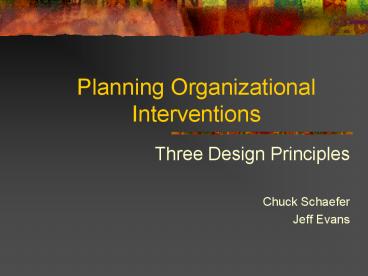Planning Organizational Interventions - PowerPoint PPT Presentation
1 / 13
Title:
Planning Organizational Interventions
Description:
Propose three principles for designing organizational interventions (current ... Emery & Trist. IP2 - Democratic Self-regulation. Democratic Self-Regulation 'Works' ... – PowerPoint PPT presentation
Number of Views:159
Avg rating:3.0/5.0
Title: Planning Organizational Interventions
1
Planning Organizational Interventions
- Three Design Principles
- Chuck Schaefer
- Jeff Evans
2
Expectations for This Session
- Propose three principles for designing
organizational interventions (current work in
progress) for consideration - Elicit feedback and pushback on these by testing
against the collective experience base here
3
Three Principles
- IP1 - organizations are open, living systems
- IP2 - democratic self-regulation works
- IP3 - co-creation accelerates transformation
4
IP1 - Open Systems
- The system learns from the environment
- The system makes plans to act on the environment
- Change occurs through planning and learning
Emery Trist
5
IP2 - Democratic Self-regulation
- Democratic Self-Regulation Works
- Interventions work better when they are
self-regulated by the participants
Lippet, Lewin, et al
6
IP3 - Co-creation Accelerates
- System adaptation comes through planning and
acting. - The more of the system is involved in adaptation,
the faster the change occurs. - If the entire system is involved, transformation
is immediate.
7
Cycle of Experience
Closure is here
Observations
Contact
Withdrawal
Action planned
Energy
Awareness
Creative indifference
8
IP 1 Examples
- Processes focused on planning and adapting
- Open and frequent communications
- Strong emphasis on the systems interaction with
the environment - Growth and change encouraged
- Experimentation is allowed
9
IP 2 Examples
- Work is coordinated and controlled at the level
is is performed - Input is expected from all levels
- Work units are responsible and responsible
10
IP 3 Examples
- Wide level of participation
- Note Communications, meetings, report-outs,
etc. are not considered participation here - Decision-making is widely distributed at the
level of the participants - The intervention encourages/supports cook time
in the workplace
11
Case One
- Division changes / merging
- Shift from functional organization to multiple
SBUs with nested PMUs - Time frame constraints
- Method selected based on above criteria
12
Case 2
- Manufacturing site
- Shift to differentiated product strategy
- Increased demands for flexibility, adaptability
- Increased demands for high skilled /
multi-skilled workforce - No prior organizational planning
13
Evaluation Matrix































